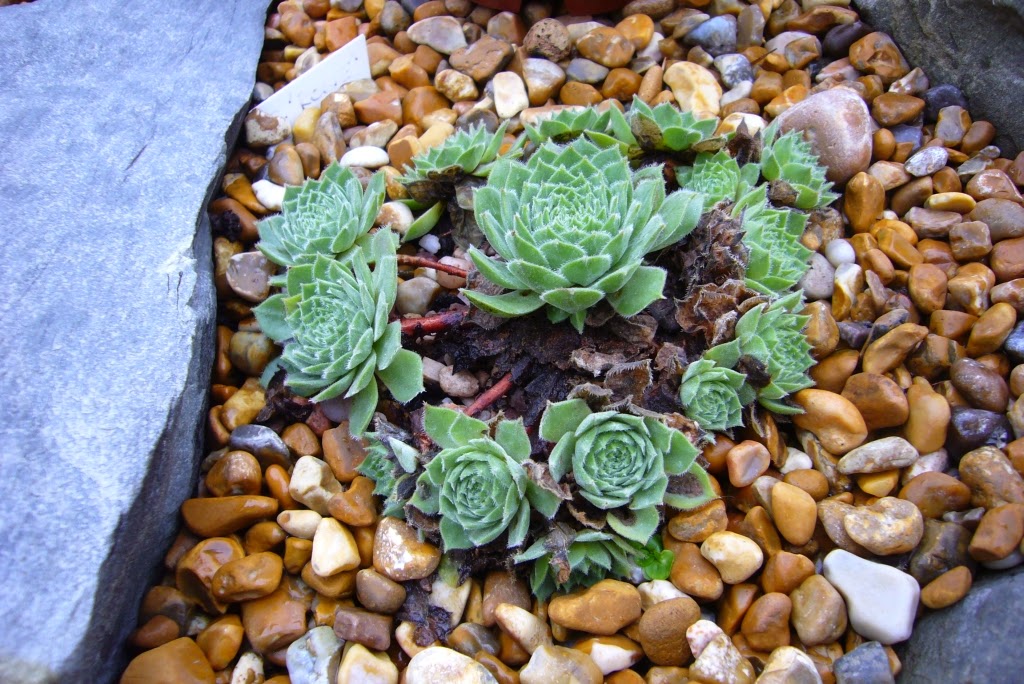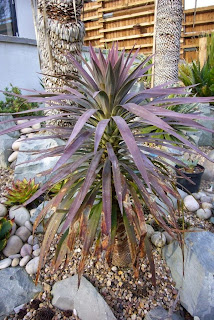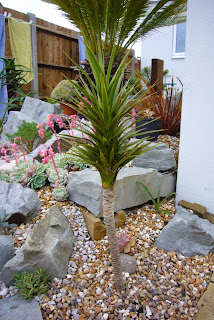It has been stresfull in the garden with the issues with the succulents, but work hasn't stopped. I'll come back to the agaves in a later post, but today it's time to focus on what else is going in the succulent rockery.
There are a few flowering plants in amoung the agaves, the aim is ultimately to have bee friendly flowers available for the entire time the bees are around.
The vertical posts work to give you different views, with the odd splash of colour peaking out form behind them. This one is pulsatilla vulgaris, it's a delicate little plant which apparently will form little cumps about 20cm across. Sady the information suggests it's a little fussy, especially about root disturbance. Hopefully the position is out of the way and in a few years there will be a nice big clump. It would be good to see a group of these flowers filling the space.
Just noticed the lizard on the rock, a present from my neice, so while not my taste, it's allowed to stay. It gets moved every time the come over, so you never know where it will pop up next.
The next one, was a bit of a test, tulips are not something you probably think in relation to succulent gardens. Probably not something I ever expected to end up in the rockery. The jury is out, and it didn't help that they flowered on the one weekend we were away.
At least they were the dwarf form they were suppose to be. Other plants are not so well behaved. The main agave bracteosa has been a bit of a pupping machine since being planted. One of todays tasks was to take off all the unwanted offsets and decide if they could be re-homed. Here is mum after the offsets had been removed.
There were three plants all with roots, the largest was re-homed to another part of the rockery. These are so reliable, that they make a good backbone to the other more risky plants.
While planting, I also added an asphodeline lutea. It has been sitting in a pot since last summer. Originally this was going in the front, but a change of plan there required a re-think. Like the tulips the jury is still out on this one. The blue leaves are lovely and the flower spikes should be good. The question is if it will be too messy for the very structured succulent rockery.
They form clumps, but if it does stay I may be tempted to keep them as individual plants and scatter them about the garden as a repeating feature. Time will tell if this one makes the grade. There is going to be a more messy/jungly part to that bed, maybe they will end up there.
It was good to spend time in the garden not worrying about the agaves and instead getting on with planting for the second summer. If you are wondering about the eremurus, they are growing away. The e. oase especially is really strong and it looks like both plants will flower this year.
It is not quite the californian version of flowers and agaves, I am working up to that. There were however lots of bees around, so hopefully as the season progresses and more flowers open they will be happy.
There are a few flowering plants in amoung the agaves, the aim is ultimately to have bee friendly flowers available for the entire time the bees are around.
The vertical posts work to give you different views, with the odd splash of colour peaking out form behind them. This one is pulsatilla vulgaris, it's a delicate little plant which apparently will form little cumps about 20cm across. Sady the information suggests it's a little fussy, especially about root disturbance. Hopefully the position is out of the way and in a few years there will be a nice big clump. It would be good to see a group of these flowers filling the space.
Just noticed the lizard on the rock, a present from my neice, so while not my taste, it's allowed to stay. It gets moved every time the come over, so you never know where it will pop up next.
The next one, was a bit of a test, tulips are not something you probably think in relation to succulent gardens. Probably not something I ever expected to end up in the rockery. The jury is out, and it didn't help that they flowered on the one weekend we were away.
At least they were the dwarf form they were suppose to be. Other plants are not so well behaved. The main agave bracteosa has been a bit of a pupping machine since being planted. One of todays tasks was to take off all the unwanted offsets and decide if they could be re-homed. Here is mum after the offsets had been removed.
There were three plants all with roots, the largest was re-homed to another part of the rockery. These are so reliable, that they make a good backbone to the other more risky plants.
While planting, I also added an asphodeline lutea. It has been sitting in a pot since last summer. Originally this was going in the front, but a change of plan there required a re-think. Like the tulips the jury is still out on this one. The blue leaves are lovely and the flower spikes should be good. The question is if it will be too messy for the very structured succulent rockery.
They form clumps, but if it does stay I may be tempted to keep them as individual plants and scatter them about the garden as a repeating feature. Time will tell if this one makes the grade. There is going to be a more messy/jungly part to that bed, maybe they will end up there.
It was good to spend time in the garden not worrying about the agaves and instead getting on with planting for the second summer. If you are wondering about the eremurus, they are growing away. The e. oase especially is really strong and it looks like both plants will flower this year.
It is not quite the californian version of flowers and agaves, I am working up to that. There were however lots of bees around, so hopefully as the season progresses and more flowers open they will be happy.














































































































